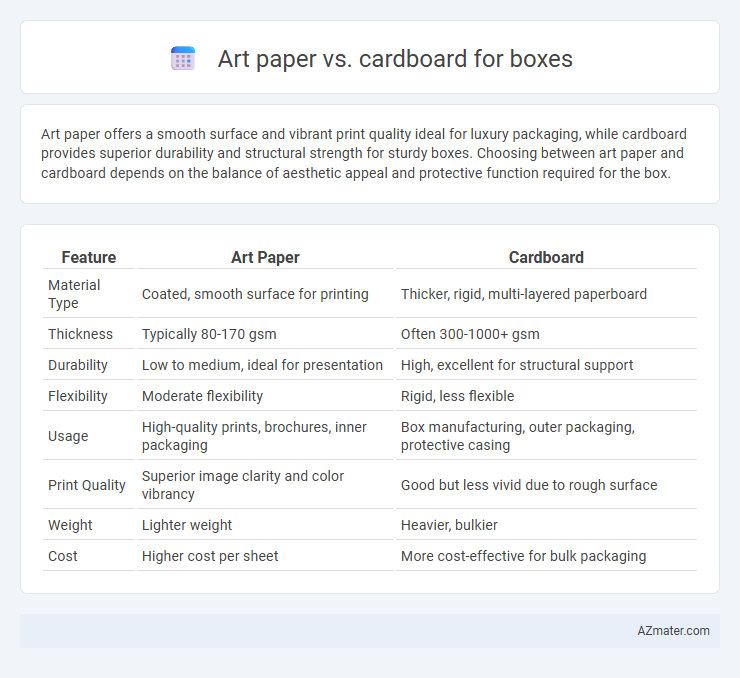Art paper offers a smooth surface and vibrant print quality ideal for luxury packaging, while cardboard provides superior durability and structural strength for sturdy boxes. Choosing between art paper and cardboard depends on the balance of aesthetic appeal and protective function required for the box.
Table of Comparison
| Feature | Art Paper | Cardboard |
|---|---|---|
| Material Type | Coated, smooth surface for printing | Thicker, rigid, multi-layered paperboard |
| Thickness | Typically 80-170 gsm | Often 300-1000+ gsm |
| Durability | Low to medium, ideal for presentation | High, excellent for structural support |
| Flexibility | Moderate flexibility | Rigid, less flexible |
| Usage | High-quality prints, brochures, inner packaging | Box manufacturing, outer packaging, protective casing |
| Print Quality | Superior image clarity and color vibrancy | Good but less vivid due to rough surface |
| Weight | Lighter weight | Heavier, bulkier |
| Cost | Higher cost per sheet | More cost-effective for bulk packaging |
Introduction to Art Paper and Cardboard
Art paper features a smooth, high-quality finish ideal for detailed printing and vibrant graphic displays, making it a preferred choice for luxury packaging and presentation boxes. Cardboard, typically thicker and more rigid, offers superior durability and structural support, commonly used in shipping and storage boxes due to its strength and protective properties. Understanding the differences in texture, weight, and functionality between art paper and cardboard is essential for selecting the right material for specific box-making applications.
Material Composition: Art Paper vs. Cardboard
Art paper primarily consists of cellulose fibers with a smooth, coated surface designed for high-quality print and visual appeal, whereas cardboard is composed of multiple layers of compressed paper pulp for enhanced durability and structural strength. The density and thickness of cardboard provide superior rigidity, making it ideal for protective packaging, while art paper's lighter, flexible nature suits decorative or branding elements on box exteriors. Understanding the distinct fiber arrangements and coating treatments helps in selecting the right material based on whether visual presentation or physical protection is the priority.
Durability and Strength Comparison
Art paper offers a smooth surface and high print quality but lacks the durability and strength required for sturdy box construction. Cardboard, especially corrugated types, provides superior structural integrity and resistance to crushing, making it ideal for packaging and shipping. The thickness and multi-layer composition of cardboard ensure enhanced durability compared to the thin, flexible nature of art paper.
Surface Texture and Print Quality
Art paper offers a smooth, refined surface texture ideal for high-quality, detailed printing with vibrant colors and sharp images, making it perfect for luxury packaging. Cardboard presents a coarser texture that may result in less precise print quality but provides superior durability and structural strength for heavier or bulkier items. Choosing between art paper and cardboard depends on the balance needed between aesthetic appeal and functional sturdiness in box manufacturing.
Cost Analysis: Art Paper vs. Cardboard
Art paper generally incurs higher production costs due to its smooth finish and premium quality, making it less economical for large-scale packaging compared to cardboard. Cardboard offers greater affordability with its thicker structure and widespread availability, significantly reducing material expenses for box manufacturing. Cost analysis favors cardboard for budget-sensitive projects, while art paper suits high-end packaging requiring aesthetic appeal despite higher costs.
Eco-Friendliness and Recyclability
Art paper, often coated and chemically treated, typically poses greater challenges for recycling compared to cardboard due to its lower biodegradability and contamination issues. Cardboard is widely recognized for its superior eco-friendliness because it is made from recycled fibers, is biodegradable, and is easily accepted by recycling programs worldwide. Choosing cardboard for box manufacturing significantly reduces environmental impact and supports circular economy principles through efficient recyclability.
Best Uses for Art Paper Boxes
Art paper is ideal for premium box packaging due to its smooth texture, vibrant printing capabilities, and excellent surface finish, making it perfect for luxury goods, cosmetics, and gift boxes. Unlike cardboard, which is thicker and more rigid but less refined, art paper provides a high-quality aesthetic that enhances brand perception without compromising on flexibility during folding and customization. Art paper boxes are best used when visual appeal and tactile experience are crucial, such as for retail packaging where presentation drives consumer engagement.
Ideal Applications for Cardboard Boxes
Cardboard boxes are ideal for packaging, shipping, and storage due to their durability, cost-effectiveness, and recyclability, making them suitable for both industrial and retail uses. They provide excellent protection for heavy or bulky items and can be easily customized with printing for branding purposes. Unlike art paper, cardboard offers superior strength and structural integrity, essential for transporting fragile or large-volume products securely.
Customization and Finishing Options
Art paper offers superior customization and finishing options compared to cardboard, enabling high-resolution prints, vibrant colors, and a smooth surface ideal for detailed graphics and brand logos. Advanced finishes such as matte, gloss, UV coating, and embossing enhance the visual appeal and tactile experience, making art paper perfect for premium packaging. Cardboard, while sturdy and cost-effective, has limited finishing options and typically supports basic printing methods, restricting intricate design possibilities and luxury branding.
Choosing the Right Material for Your Box
Art paper offers a smooth, high-quality finish ideal for presentation boxes, enhancing brand appeal with vibrant printing and detailed graphics. Cardboard provides superior strength and durability, making it suitable for shipping boxes that require protection and structural integrity. Selecting the right material depends on balancing aesthetic impact with functional requirements, ensuring the box meets both visual and practical needs.

Infographic: Art paper vs Cardboard for Box
 azmater.com
azmater.com